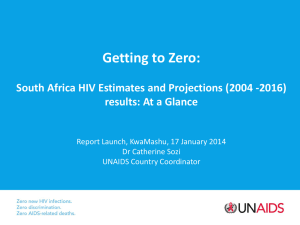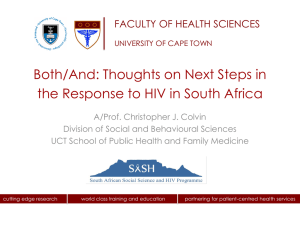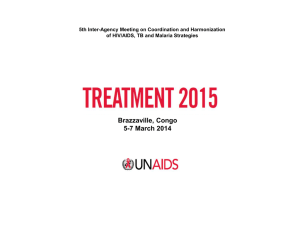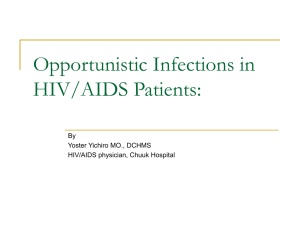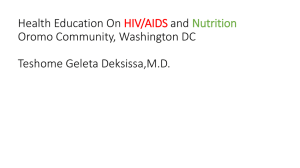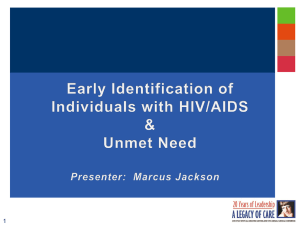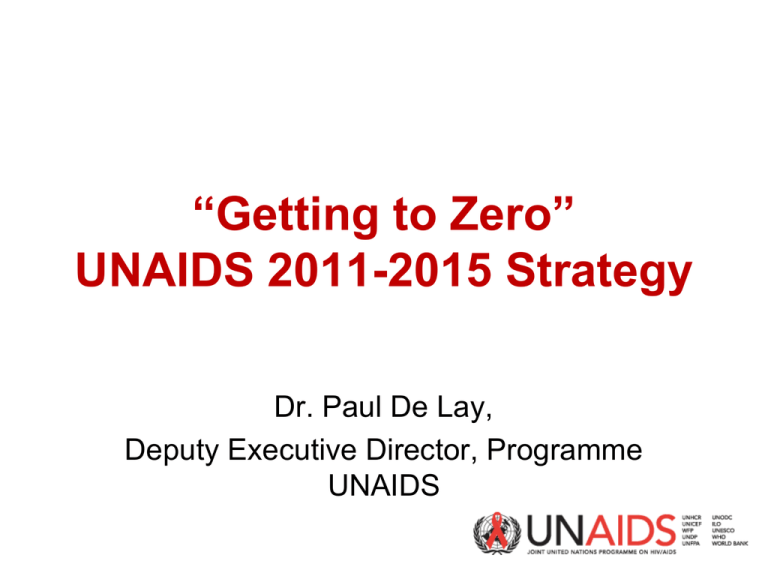
“Getting to Zero”
UNAIDS 2011-2015 Strategy
Dr. Paul De Lay,
Deputy Executive Director, Programme
UNAIDS
UNAIDS Strategy
Defines an aspirational vision for the
future of the AIDS response
Outlines 10 concrete goals to guide the
global response to HIV for the next five
years and focus the work of the United
Nations on HIV.
VISION
ZERO NEW HIV INFECTIONS.
ZERO DISCRIMINATION.
ZERO AIDS-RELATED DEATHS.
Strategic Directions
Revolutionizing HIV
prevention
Political commitment to why
people are getting infected
Communities demand
transformative change
Resources directed to
hotspots and what works
Catalysing the next phase
of treatment, care & support
Access to effective treatment
when people need it
Strong national & community
systems
Access to care, support &
social protection
Advancing human rights &
gender equality
Protective social & legal
environments enable access
Equitable service provision
reaches people most in need
HIV-related needs and rights
women and girls addressed
Goals for 2015
Concrete, ambitious yet achievable milestones
Ten concrete medium-term milestones on road to long-term
vision
Established to guide global response and Joint Programme
Ambitious – UNAIDS role to lead and inspire
Evolved from Outcome Framework priority area working
groups
Capture areas where real progress is needed
Goals for 2015
Sexual transmission of HIV reduced by half, including among young
people, men who have sex with men and transmission in the context of
Revolutionise
sex work
HIV
Vertical transmission of HIV eliminated and AIDS-related maternal
prevention
deaths reduced by half
All new HIV infections prevented among people who use drugs
Catalyse the
next phase of
treatment,
care and
support
Advance
human rights
and gender
equality
Universal access to antiretroviral therapy for people living with HIV
who are eligible for treatment
TB deaths among people living with HIV reduced by half
People living with HIV and households affected by HIV are addressed
in all national social protection strategies and have access to
essential care and support
Countries with punitive laws and practices around HIV transmission,
sex work, drug use or homosexuality that block effective responses
reduced by half
HIV-related restrictions on entry, stay and residence eliminated in half
of the countries that have such restrictions
Zero tolerance for gender-based violence
HIV-specific needs of women and girls addressed in at least half of all
national HIV responses
Transformation agenda
Focus and efficiency to radically reduce new infections, catalyse
treatment access and advance human rights and gender equality
Focus – Directing resources to where they have most impact on the
epidemic—to hotspots, interventions, countries
Efficiency – Reducing unit cost, innovative delivery systems, involving
communities, integrating services
Partnership – Supporting country ownership and south-south
cooperation, engaging communities and emerging economies
Enhancing mutual accountability through shared ownership
People centered
Country focused
Builds on Synergies
All new HIV infections prevented
among people who use drugs
by 2015
Figure 3.5
Availability of sterile injecting equipment, 2010
Global estimates of the availability of sterile injecting equipment per person who uses drugs per year, 2010.
9
Source: Mathers BM, Degenhardt L, Ali H, Wiessing L, Hickman M, Mattick R, et al. HIV prevention, treatment and care for people who inject drugs: A systematic review of global, regional
and national coverage. The Lancet 2010;379:1014-28.
Global availability of OST
Source: Mathers et al HIV prevention, treatment and care for people who inject drugs: A
systematic , review of global, regional and country level coverage Lancet 1 March 2010
buprenorphine maintenance
MMT
MMT and buprenorphine maintenance
OST present but medication type not reported
OST not present
No reports identified on presence or absence of OST
No reports of injecting drug use occurring
Effective …
Methadone and buprenorphine—are effective
in treating dependence on opioids. … Drug
users who remain in treatment and receive
sufficient doses of the medication, experience
greater benefits, including protection against
HIV infection. … high-risk countries should
make such treatment widely available, where
feasible.
Multi-component HIV prevention programs
that include sterile needle and syringe access
are effective in reducing drug related HIV risks
such as needle and syringe sharing.
nations should take steps to better align law
enforcement and public health approaches.
… and cost effective.
• In the Ukraine needle and syringe programmes
are estimated to cost less than $100 per HIV
infection averted.
• In Australia the return on investment of a decade
of needle and syringe programmes was
estimated at one and a half billion US dollars.
Getting to Zero
Bold Results for 2011
In 10 of the 20 countries where the epidemic is driven by unsafe drug
use or where unsafe drug use threatens a new wave of HIV infections:
1. Regulations and policies will be implemented to support evidencebased harm reduction and drug dependence treatment services in
relation to injecting drug use and non-injecting stimulant use.
2. Needle and syringe programmes will be extended to regularly reach
40% of people who inject drugs, and opioid substitution therapy will be
extended to regularly reach 10% of people who inject opioids.
3. Uptake of antiretroviral therapy for people who use drugs and are living
with HIV will double.
An agenda for efficiency and focus
$17.4
$17,0
17.5
$15.9
$15.6
15.0
$14,3
$14.4
$12,8
12.5
US$ billion
$11.4
Signing of Declaration of Commitment
on HIV/AIDS UNGASS 2001
10.0
$8.9
$09,9
$8.3
7.5
HIP+
$6.1
World Bank
MAP launch
UNITAID
$5.0
5.0
$3.2
UN AIDS
Gates
Foundation
PEPFAR
2.5
$0.3
$0.5
$0.9
$0.5
The Global Fund
$1.6
$1.4
0.0
1996
1997
1998
1999
2000
2001
2002
2003
2004
2005
2006
2007
2008
2009
The 2011 High Level Meeting
will allow us to
Review progress
since 2001
Chart the way
forward
Renew resolve
The 2011 High-Level Meeting on AIDS comes at
a pivotal moment in the history of the
epidemic. Thirty years into the AIDS response,
let us unite for universal access. Let us, once
and for all, set the course for zero new HIV
infections, zero discrimination, and zero AIDSrelated deaths.
UN Secretary General Ban Ki-moon

